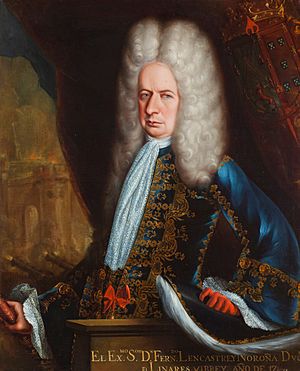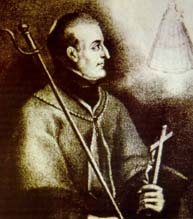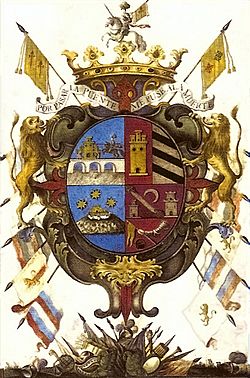Pious Fund of the Californias facts for kids
The Pious Fund of the Californias was like a special savings account. It started way back in 1696. Its purpose was to help pay for Roman Catholic missions in a region called the Californias. These missions were built by different groups of priests: the Jesuits, Dominicans, and Franciscans. They worked in what is now Baja California and California in the United States. This fund helped these missions from 1697 until 1834. The Jesuits first managed the fund. Later, in the 1800s, the fund became part of a legal disagreement between the United States and Mexico. This disagreement was finally settled in 1902 in a court in The Hague.
Contents
How the Fund Started
The idea for the Pious Fund began in 1689. Two priests, Eusebio Kino and Juan Maria Salvatierra, were traveling together. They decided to ask people for donations to help the Jesuits spread their faith in Baja California.
Who Donated to the Fund?
Many people donated money to the fund. These donors were often merchants who worked with silver mines. They lived in areas like Sonora and Sinaloa, which are now parts of Mexico. Other big donors were important merchants from Mexico City. Even powerful leaders, like viceroys, supported the fund.
How Donations Helped Missions
A donation of 10,000 pesos was a lot of money back then. This amount could earn about 500 pesos in interest each year. That 500 pesos was enough to pay for one missionary and run his mission. This money helped the Jesuits build a Spanish presence in Baja California. They also taught the Catholic faith and new farming methods to the local people. Most of the Jesuit missions were in Baja California Sur.
Changes to the Fund's Management
In 1767, the King of Spain decided to remove all Jesuits from Spanish lands. After this, the Spanish government took over the Pious Fund. They used the money to pay other groups of priests. The Dominicans took over the old Jesuit missions in Baja California. They also started new missions in that area. The Franciscans started missions in what is now California, in the United States. Both of these areas were part of New Spain at the time.
The Franciscans built 21 missions between San Diego and Sonoma. This region later became the US state of California in 1848. The early donations to the fund were managed from Mexico City. The missionaries in Baja California lived very simply, using only the interest from the fund.
Important Donors and Missionaries
The biggest donor between 1702 and 1741 was Jose de la Puente y Pena and his family. He was a silver merchant. He might have also traded goods with Asia. Mission San Jose del Cabo was named after him. Large Spanish ships, called Manila galleons, used to stop there.
The most active missionaries were Juan María de Salvatierra, who founded many missions in Baja California. Juan de Ugarte was also very active. Eusebio Francisco Kino founded many missions in the Sonoran Desert and Baja California. After 1741, some donations came in the form of livestock farms. These farms raised sheep that were sent to Mexico City for meat. The money from selling the animals then helped pay the 500 pesos for each mission.
Later Years of the Fund
In 1768, after the Jesuits were removed from Spanish lands, the King of Spain took control of the fund. Spain managed the fund until Mexico became independent in 1821. During this time, the Franciscans worked in Upper California. The Dominicans worked in Lower California. Before the Jesuits left, 13 missions had been built in Lower California. By 1823, the Franciscans had built 21 missions in Upper California.
When Mexico became an independent country in 1821, its new government took over the fund. They managed it until 1840.
The Fund and the Bishopric
In 1836, Mexico passed a law to ask the Pope to create a new church area called a bishopric in Alta California. The law said that once this bishopric was created, the Pious Fund would be given to the new bishop. The bishop would then manage the fund for its original purposes.
In response, Pope Gregory XVI created the Roman Catholic Diocese of the Two Californias in 1840. He appointed Francisco Garcia Diego y Moreno as the first bishop. Soon after, Mexico gave the Pious Fund properties to Bishop Diego. He managed them until 1842.
The Fund is Sold
In 1842, General Antonio López de Santa Anna, who was the President of Mexico, made a new rule. He said the government should take charge of the fund again. The properties of the fund were given to the Mexican government in April 1842.
On October 24, 1842, General Santa Anna ordered that the fund's properties be sold. The money from the sale went into the national treasury. The government promised to pay 6% interest each year on the total amount from the sale. This money was meant to continue supporting the missions. The government specifically promised to use money from tobacco sales to make these payments.
See also
 In Spanish: Fondo Piadoso de las Californias para niños
In Spanish: Fondo Piadoso de las Californias para niños
- Spanish missions in Baja California
- Spanish missions in the Sonoran Desert
- Spanish missions in Arizona
- Spanish missions in California
- The Roman Catholic Church and Colonialism
- Spanish colonization of the Americas





